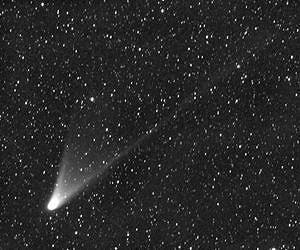PANSTARRS barely naked eye, easy in binoculars starting March 7

Comet PANSTARRS (right) won't be the spectacular visitor we expected, but it seems that it will be visible to the naked eye- barely- here in the Northern Hemisphere beginning March 7.
The comet has reached the vicinity of magnitude 4.2 below the equator, where it is already visible. Venus, to provide a standard of comparison, is -5 magnitude (the lower the magnitude is, oddly, the brighter the object is). Sirus, the brightest actual star in the sky, is magnitude -1, which is also the brightest absolute magnitude Comet Hale-Bopp reached.
The comet will best be seen in dark skies, and a pair of binoculars will probably be necessary to make out its tail. PANSTARRS will be something of a disappointment, given the high hopes the astronomical community had for it earlier. But the main event- Comet ISON, billed, like Hale-Bopp, as "the comet of the century-" is still headed our way in November:
A second comet- Comet Lemmon- is also visible currently, at magnitude 6. It is green. And no, it has nothing to do with this.


Comments